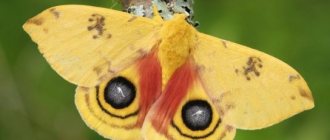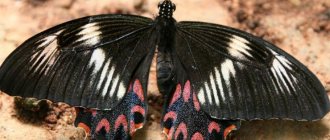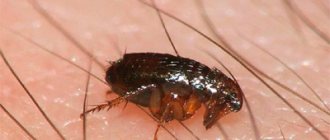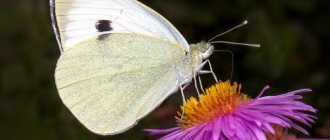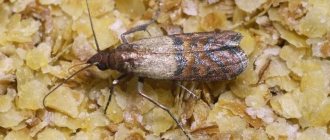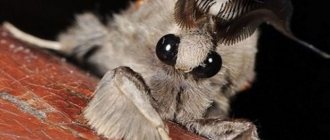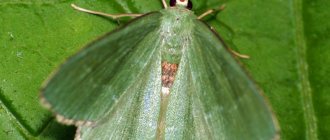One of the greatest natural miracles is the transformation of a fat and clumsy caterpillar into a butterfly. Moreover, the butterfly is not always more beautiful than its larva - some caterpillars are so unusual, brightly colored and have a bizarre shape that the butterfly, especially if it is nocturnal, looks like an ugly duckling next to it.
This review contains magnificent photos illustrating what caterpillars of some species look like and what kind of butterfly they turn into. And also, some interesting facts about these incomparable creatures of nature are presented.
Brahmin Moth
Brahmei butterflies are found in the East - in India, China, Burma, and are also common on some islands of Japan.
This is a nocturnal species of butterfly; they fly at night and sleep during the day with their wings spread. Butterflies and caterpillars are poisonous, so they have no enemies.
Peacock eye cecropia (Hyalophora cecropia)
The caterpillar is very poisonous, so with all its bright color it shows that it is better not to touch it. The tubercles have a rich color and additionally have dots, like those of poisonous ladybugs.
The peacock eye is the largest moth in America - larger than the palm of your hand.
Description of the appearance of the moth caterpillar
Like butterflies, moth caterpillars have camouflage coloration , the color of which depends on the type of vegetation that is the main food supply of the insect.
The thin bodies are practically naked and have no villi. distinguished by their amazing ability to pretend to be branches, stems , cuttings and other parts of the plant, which makes them quite difficult to recognize even if they are close.
Photos of different types of land surveyors:
Freezing in a protruding position by holding one pair of abdominal legs by a plant branch, they become invisible to their immediate enemies - sparrows , tits , nightingales and other small birds . They achieve such camouflage due to highly developed muscles.
If it falls due to a strong gust of wind or danger, the insect rises along a thread, with the help of which it is attached to leaves and branches.
It is important! The main feature of this family of caterpillars is the peculiar arrangement of the abdominal legs. They are located on the 6th and 10th (sometimes 5th and 6th or 4th and 5th) segments of the body, which explains their unusual method of movement, during which the back of the body is pulled towards the front, as if measuring the distance with spans. In fact, this is how they got their name.
The unusual loop-like bending of the body gave birth to another name for this family - they are also often called land surveyor caterpillars.
Spicebush Swallowtail
At first glance, this creature looks more like a fish or lizard than a caterpillar. Huge false eyes scare away predators. In addition, during its life of a couple of months, the larva changes color - the egg hatches chocolate brown with large white spots, then becomes bright emerald, and before pupation - orange with a red belly.
The black-blue velvet butterfly is common in North America; in some places it gathers in colonies of hundreds of thousands of specimens.
Insect habitat
This species of butterfly can be found in most of Europe and Asia, as well as in North America. The insect can live even at an altitude of up to 3000 m above sea level. In Russia, the kaya bear is found in almost all regions, including Siberia and the Far East.
Black Swallowtail
The caterpillar of the black swallowtail is very bright and noticeable - so that predators do not covet it. Although in fact it is quite edible.
This is undoubtedly one of the most beautiful European butterflies. During the flight, you can see how the color of the wings of the black swallowtail shimmers.
Coquette caterpillar. Megalopyge opercularis
One of the most beautiful, but at the same time poisonous caterpillars on the planet, lives in North America. The poisonous spines are covered with hair, which makes the caterpillar look more like a kitten.
The hairy caterpillar has a reddish color and grows from 2 to 3 cm in length. When it comes into contact with human skin, the spines with poison break, and the poison causes burning pain and redness.
Because of her bizarre appearance, she was nicknamed “coquette,” but because of her poison, she is called “fiery creature.” But many people know this “beauty” as Donald Trump’s hairstyle, due to their similarity.
15
Tailed Emperor Butterfly (Polyura Sempronius)
This is not a dinosaur, but a soft imperial caterpillar. Its size is up to 2 cm, and the shell visually enlarges the baby and scares the birds.
The “tailed emperor” is found only in Australia and feeds on nectar from only one plant.
Dalcerida (Acraga coa)
The Dalcerida caterpillar appears glassy and transparent.
At the same time, the butterfly itself is very shaggy, brick-colored. Refers to moths. Lives in the tropical forests of Mexico.
Nutrition
Hairy caterpillars in most cases eat plant foods - juices of fruits, plants, nectar. However, among them there are predators that eat their own kind - weakened, diseased larvae, butterflies, other small insects, and aphids.
- Polyphages are absolutely indiscriminate in their food, eating almost all vegetation. They lead a predominantly nocturnal lifestyle.
- Oligophages eat plants of a certain species or genus. Thus, the caterpillar of the swallowtail butterfly feeds exclusively on umbrellas.
- Monophages live and eat one plant. If a particular shrub is heavily infested, other plant species adjacent to it remain completely safe.
- Xylophages do not eat anything except wood. This group of caterpillars is always distinguished by a large number of individuals in one brood.
The transitional form is furry creatures that eat tinder fungi and lichens. A separate group includes keratophages, which feed on elements of animal origin - horny cover, wool, skin, hair.
Furry caterpillars
The hairy caterpillar butterfly is an ancient inhabitant of our planet, whose roots go back to the time of dinosaurs. There is a huge variety of larvae in the world, distinguished by their unusual appearance and the presence of body hairs of different lengths. A photo of the furry caterpillar is presented below.
On a note!
The furry caterpillar may look quite attractive, but you should not touch it out of curiosity. In most cases, the hairs contain a special poison, which, when it comes into contact with the skin or wound, causes serious irritation of the skin, deterioration of general health - headache, chills, nausea, dizziness, etc.
Moth (Acharia Stimulea)
This strange creature of incomprehensible color, with a bright green blanket, is a very dangerous creature. Each shoot secretes poison, and even one touch to the caterpillar can put an adult in the hospital.
And the butterfly is an ordinary night moth, almost invisible.
Saddle caterpillar. Acharia Stimulea
Another beautiful caterpillar, native to North America, attracts attention with its unusual bright color and unique body structure.
The head and back of the body are crowned with massive horns, which, like the legs, are covered with hairs. It is these hairs that contain poison, so zoologists advise staying away from these creatures.
Touching the hoary caterpillar causes a burn, and the area of contact becomes covered in a rash. The pain of the touch is comparable to a bee sting.
13
Witch moth caterpillar (Phobetron pithecium)
A real caterpillar witch! Lives in orchards of both American continents. It is also called the “slug monkey” for its unusual method of movement - it crawls along one leaf and jumps onto another leaf.
Witch butterflies are also quite spectacular and large. They are nocturnal.
Appearance of hairy baby butterflies
Furry caterpillars
Photos and names of furry caterpillars are presented below. The variety of butterflies and their larvae, colors, and appearance is surprising.
- Yoke. Outwardly it resembles a miniature, harmless, fluffy or hairy animal. However, hidden under the attractive coat are thorns with quite strong poison. Within 5 minutes after touching a strange creature, a throbbing pain appears in the armpit. This is followed by general malaise and signs of intoxication of varying severity. The area touched by the hairy baby butterfly becomes covered with red spots and a rash.
- Traveling silkworm. A black furry caterpillar lives high on a pine tree. Hairy creatures settle in numerous colonies in a large silken nest. Butterflies lay eggs in huge numbers. They feed on the juices of needles and move together in a colony, following one after another. The entire body is covered with hairs and contains poison inside. Touching a person ends in irritation of the skin, and signs of intoxication may be present.
- A hairy caterpillar hiding in a sac. The name of the black hairy caterpillar characterizes its lifestyle. During the day, the larvae hide en masse in a special silk bag, which they form for themselves. At night they move in groups in search of food. They resemble the appearance and lifestyle of traveling silkworm larvae, but are more dangerous to humans. The large hairy caterpillar contains anticoagulant poison, which prevents blood from clotting and can cause internal bleeding. The butterfly is absolutely safe.
- Ursa crusadus. The black and orange hairy larva is dangerous due to the consumption of large quantities of juice from a poisonous plant - ragwort. In North America, butterflies and their offspring are used to destroy harmful plants in the area. The hairy caterpillar is dangerous for cattle and horses. An animal can die from its presence on the body. It brings a temporary deterioration in health to a person.
- Witch moth. Brown, shaggy, unusual shape. More like a flower with petals. Lives in orchards, feeds on the juices of plants and vegetables. It does not pose any particular danger to humans, but after touching, a rash, redness, and itching are observed.
- Volnyanka. The furry black-and-red caterpillar has a red head. The body is black, with red stripes with spikes on the sides. The red color of the head warns of the danger of a small creature. The pest lives on trees and eats the bark. With a large number of larvae, the plant risks dying. You should not remove the caterpillar from the tree with your hands; the larva stings unpleasantly, causes an allergic reaction on the skin, and general malaise.
- Saddle-haired. A red caterpillar with a light green pattern. Outwardly it resembles a dog in bright clothes. Muzzle, tail, back. The light green pattern on the body looks like a saddle. This is where the name comes from. An attractive hairy creature is dangerous to human health. There are spines with poison on the fleshy horns on both sides of the body.
The furry caterpillar goes through several stages of development and molts from 2 to 6 times during its maturation. At different stages of development, it can differ significantly in appearance - from naked to shaggy, from hairy to smooth.
Greta Oto, or Glass Winged Butterfly
The caterpillar of the incredible Greta butterfly looks ordinary and does not attract attention.
But the glass butterfly with transparent wings looks simply amazing. This species lives in Mexico and throughout South America.
Lonomy. Lonomia Obliqua
Let’s complete our list with an unusual and most poisonous caterpillar that can be found in the forests of Central and South America.
The Lonomiya caterpillar reaches a length of up to 7 cm and lives on tree trunks and branches. Because of its color and fluffy hairs on its body, it is very difficult to notice, but meeting it carries a considerable danger to human health and life.
When touched, the caterpillar releases toxic poison, causing severe burns and swelling. History has recorded cases where contact with Lonomiya led to death.
